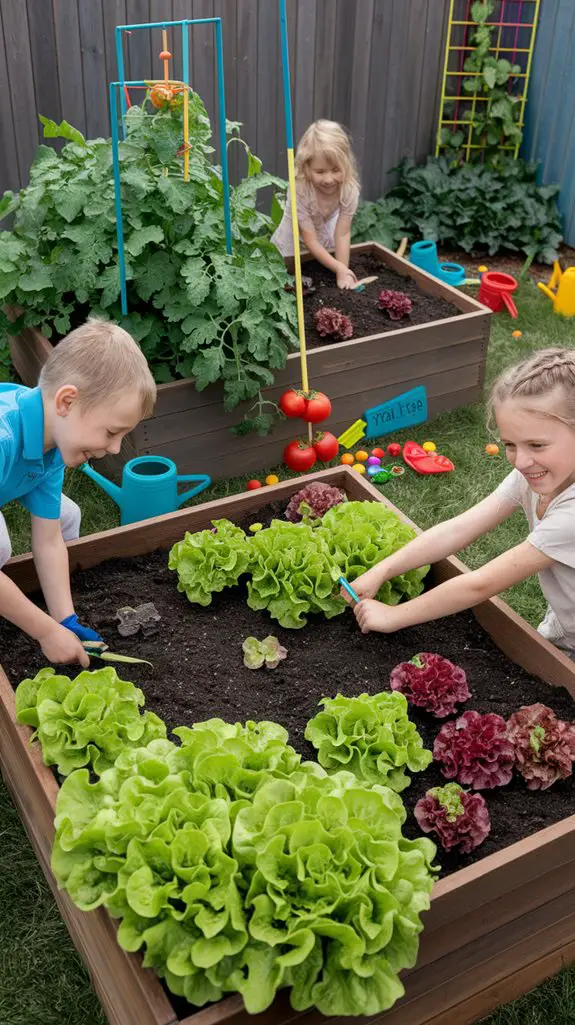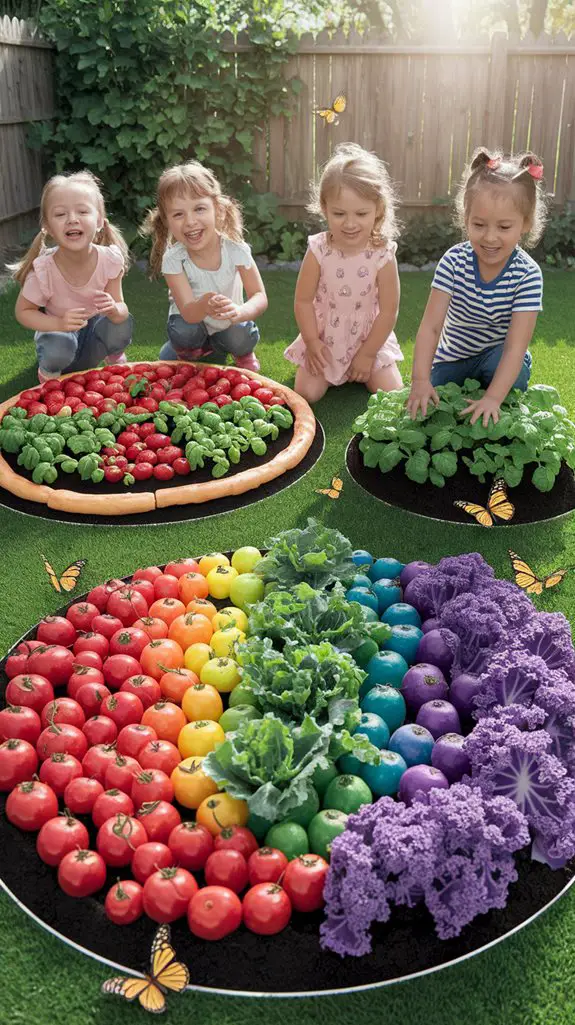Looking to transform your backyard into a kid-friendly vegetable garden wonderland? You’ll find that gardening offers children more than just fun—it’s a hands-on education in biology, nutrition, and environmental stewardship. From miniature garden beds sized for small hands to themed plots that spark imagination, the possibilities extend well beyond basic planting. Discover how colorful produce varieties and recycled container gardens can captivate even the shortest attention spans and foster a lifelong connection to growing food.
Creating Child-Sized Garden Beds for Easy Access
When designing garden spaces for children, size appropriateness becomes a critical factor in fostering engagement and independence. Construct raised beds at 24-30 inches wide rather than standard 4-foot widths to accommodate shorter arm reaches. Ideal height should be 8-12 inches for younger children (ages 3-5) and 12-18 inches for older kids (ages 6-10).
Incorporate ergonomic considerations by installing stepping stones between rows, allowing access without soil compaction. Edge beds with rounded lumber or composite materials to prevent splinters and injuries.
For enhanced accessibility, install U-shaped garden configurations that enable children to work from multiple angles. You’ll find that these properly scaled environments encourage prolonged participation while developing fine motor skills and plant stewardship naturally through daily interaction with appropriately sized growing spaces. Additionally, utilizing container vegetable gardening can further enhance the gardening experience by allowing for flexibility in plant selection and ease of maintenance.
Planting Fast-Growing Vegetables for Quick Results

Because children naturally exhibit limited patience when gardening, selecting vegetables with rapid growth cycles becomes essential for maintaining their enthusiasm.
Focus on radishes, which emerge in just 3-4 weeks, providing nearly immediate gratification. Leaf lettuce offers another quick option, ready for harvest within 21 days as baby greens. Green onions (scallions) sprout rapidly and can be harvested partially while continuing to grow.
For slightly longer projects, consider bush beans that produce within 45-60 days, or snow peas that thrive in cooler weather and mature quickly. Spinach and microgreens also deliver fast results. Additionally, incorporating raised bed herb gardens can enhance the gardening experience by providing a structured space for young gardeners to experiment with herbs alongside their vegetables.
Arrange these quick-growing options in dedicated sections of your child’s garden, allowing them to track progress weekly. This strategic planting schedule creates consistent harvesting opportunities that sustain children’s interest throughout the growing season.
Designing Themed Garden Spaces Like Pizza or Rainbow Gardens

Themed garden spaces transform ordinary vegetable plots into engaging, conceptual landscapes that captivate children’s imagination while teaching them about plant diversity and food origins.
Two particularly effective designs are pizza and rainbow gardens.
For pizza gardens, arrange a circular plot divided into triangular “slices.” Plant tomatoes, basil, oregano, bell peppers, and garlic—all pizza ingredients—in separate wedges. Use a central stake with string to create the circular outline.
Rainbow gardens utilize plants of sequential colors. Start with red (cherry tomatoes, radishes), then orange (carrots), yellow (squash), green (lettuce, cucumbers), blue (cabbage), and purple (eggplant). Arrange crops in arched rows mimicking a rainbow’s shape.
These designs reinforce color recognition, vegetable varieties, and ecological relationships while creating a cohesive gardening narrative that children can easily comprehend and enthusiastically participate in. Additionally, incorporating edible landscaping ideas allows for a more diverse and functional garden space.
Setting Up a Worm Farm to Learn About Composting
Beyond themed planting designs, a worm farm offers children hands-on experience with nature’s recycling system. Start with a plastic bin (12-18 inches deep) with drainage holes, layered with shredded newspaper, garden soil, and food scraps. Red wigglers (Eisenia fetida) are ideal composting worms—add 1 pound per square foot of surface area. Teach kids to feed worms weekly with vegetable scraps, coffee grounds, and eggshells. Avoid meat, dairy, citrus, and onions which create odors and attract pests. To further enhance the garden’s health, consider incorporating natural pest control methods that complement the worm composting process. Maintain 70-75°F temperatures and 70-80% moisture—like a wrung-out sponge. After 3-4 months, harvest the nutrient-rich castings by moving contents to one side and adding fresh bedding to the empty side. The worms will migrate, leaving behind black gold for your garden.
Building Scarecrows and Garden Decorations Together
Creating garden decorations provides children with an artistic outlet while serving practical purposes in the vegetable garden. Start with a traditional scarecrow using old clothes stuffed with hay or newspaper, secured on a wooden cross frame. Ascertain stability by driving the main post 12-18 inches into the ground.
Incorporate recycled materials for additional decorations—painted rocks as row markers, tin can wind chimes to deter birds, or bottle cap mosaics on stepping stones. Let children customize clay pots with weather-resistant acrylic paints, creating personalized planters for their vegetables. Additionally, involving children in the planning stage of the garden helps them understand the importance of layout and plant selection.
For technical durability, seal all painted items with polyurethane spray and use galvanized wire for assemblies.
Position decorations strategically: scarecrows at garden perimeters and shiny objects near vulnerable crops to maximize bird deterrence while enhancing the garden’s aesthetic appeal.
Growing Unique Varieties Like Purple Carrots and Striped Tomatoes
Introducing children to unusual vegetable varieties can transform a standard gardening experience into an exciting botanical adventure. Purple carrots (high in anthocyanins) and ‘Green Zebra’ striped tomatoes captivate young gardeners while teaching botanical diversity. Select varieties with manageable growing periods—’Dragon’ purple carrots mature in 70 days, while ‘Tigerella’ tomatoes ripen within 65 days of transplanting. Prepare soil with compost at a 2:1 ratio for these specialty cultivars, and maintain consistent moisture levels (1-2 inches weekly). Document the growth process with measurement charts and photographs to reinforce scientific observation skills. These uncommon vegetables also provide opportunities to discuss genetics and plant breeding concepts—explaining how selective cultivation has produced the vibrant colors and patterns they’re growing. Additionally, raised garden beds can create an accessible and organized space for children to explore their gardening skills.
Starting an Herb Sensory Garden for Touch and Smell Exploration
Herb sensory gardens bring together fragrant and textually diverse plants that appeal directly to children’s natural curiosity through multisensory engagement.
Select herbs with distinct tactile qualities like fuzzy sage, feathery dill, and smooth mint. Arrange plants in accessible containers or raised beds at children’s height to encourage exploration.
Include herbs with contrasting scents: sweet basil, citrusy lemon balm, and pungent rosemary.
Create designated “touch and smell” stations with labeled plants and simple instructions for proper handling techniques. You’ll find children develop deeper connections to plants when they crush leaves between fingers to release essential oils. Additionally, incorporating native plants into your sensory garden can enhance biodiversity and attract local wildlife, enriching the overall experience for children.
This garden serves both educational and culinary purposes—harvest herbs with your children to incorporate into simple recipes, teaching them the full cycle from garden to table.
Using Recycled Materials for Creative Garden Containers
When household items reach the end of their primary purpose, they often present ideal opportunities for creative garden containers that teach children sustainability practices.
Repurposing everyday objects reduces landfill waste while providing unique microenvironments for plant growth. Additionally, using recycled materials for gardening not only fosters creativity but also encourages environmental responsibility in young gardeners.
Select containers that offer proper drainage and adequate depth for root development. Plastic milk jugs, cut horizontally, function effectively for shallow-rooted crops like lettuce and radishes. Old boots, when waterproofed properly, accommodate small herb plantings.
Consider these high-performing recycled container options:
- Five-gallon buckets – Ideal for tomatoes, requiring only drill-created drainage holes
- Wooden dresser drawers – Perfect depth for carrots when lined with landscape fabric
- Colanders/sieves – Built-in drainage makes these excellent for strawberry plantings
Ensure all containers are thoroughly cleaned before use to remove potential contaminants that might affect plant health or food safety.
Planning Garden Scavenger Hunts and Outdoor Activities
Garden scavenger hunts transform ordinary outdoor spaces into interactive learning environments where children develop observational skills while engaging with plant life cycles. You’ll find these activities reinforce botanical knowledge while maintaining children’s enthusiasm for gardening. Additionally, children can learn how to transform kitchen scraps into valuable compost, enhancing their understanding of sustainability in gardening.
| Activity Type | Implementation | Age Range | Duration | Materials Needed |
|---|---|---|---|---|
| Color Hunt | Find items of specified colors | 3-5 | 15 min | Color cards |
| Plant Parts | Identify different plant structures | 6-8 | 20 min | Magnifying glasses |
| Insect Search | Document beneficial garden insects | 7-10 | 30 min | Notebooks, pencils |
| Texture Tour | Collect items with varied textures | 4-6 | 15 min | Collection bags |
| Harvest Quest | Gather ready-to-harvest vegetables | 5-10 | 25 min | Baskets, scissors |
Create custom hunts based on your garden’s specific plants and seasonal changes. Laminate clue cards for reuse throughout the growing season.
Conclusion
As you cultivate your child’s gardening interest, you’ll witness a metamorphosis rivaling Dahl’s James and his giant peach. The technical benefits extend beyond simple entertainment—children develop fine motor skills through seedling transplantation, learn systematic observation protocols, and internalize basic botanical classification. Implement these specialized activities strategically throughout the growing season, and you’ll establish both sustainable environmental practices and neurological pathways for lifelong scientific inquiry. Your backyard laboratory awaits.




